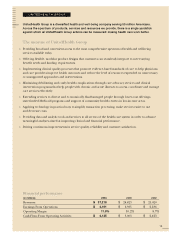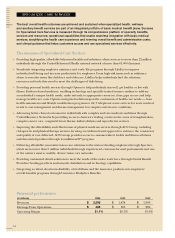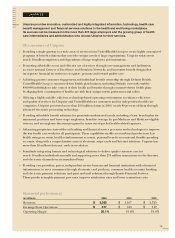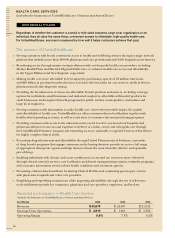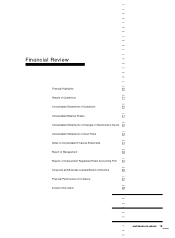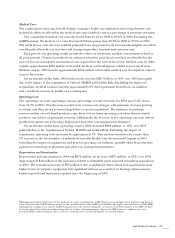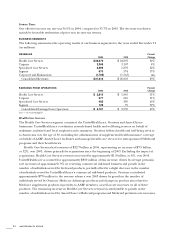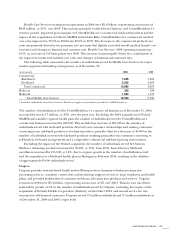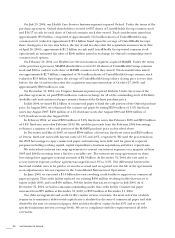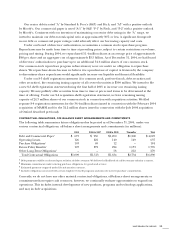United Healthcare 2004 Annual Report Download - page 25
Download and view the complete annual report
Please find page 25 of the 2004 United Healthcare annual report below. You can navigate through the pages in the report by either clicking on the pages listed below, or by using the keyword search tool below to find specific information within the annual report.
UNITEDHEALTH GROUP 23
Medical Costs
The combination of pricing, benefit designs, consumer health care utilization and comprehensive care
facilitation efforts is reflected in the medical care ratio (medical costs as a percentage of premium revenues).
The consolidated medical care ratio decreased from 81.4% in 2003 to 80.6% in 2004. Excluding the
AARP business,
1the medical care ratio decreased 50 basis points from 80.0% in 2003 to 79.5% in 2004.
The medical care ratio decrease resulted primarily from net premium rate increases that slightly exceeded
overall medical benefit cost increases and changes in product, business and customer mix.
Each period, our operating results include the effects of revisions in medical cost estimates related to
all prior periods. Changes in medical cost estimates related to prior fiscal years that are identified in the
current year are included in total medical costs reported for the current fiscal year. Medical costs for 2004
include approximately $210 million of favorable medical cost development related to prior fiscal years.
Medical costs for 2003 include approximately $150 million of favorable medical cost development related
to prior fiscal years.
On an absolute dollar basis, 2004 medical costs increased $6.3 billion, or 30%, over 2003 principally
due to the impact of the acquisitions of Oxford, MAMSI and Golden Rule. Excluding the impact of
acquisitions, medical costs increased by approximately 8% driven primarily by medical cost inflation
and a moderate increase in health care consumption.
Operating Costs
The operating cost ratio (operating costs as a percentage of total revenues) for 2004 was 15.4%, down
from 16.9% in 2003. This decrease was driven by revenue mix changes, with premium revenues growing
at a faster rate than service revenues largely due to recent acquisitions. The existence of premium
revenues within our risk-based products cause them to have lower operating cost ratios than fee-based
products, which have no premium revenues. Additionally, the decrease in the operating cost ratio reflects
productivity gains from technology deployment and other cost management initiatives.
On an absolute dollar basis, operating costs for 2004 increased $868 million, or 18%, over 2003
primarily due to the acquisitions of Oxford, MAMSI and Golden Rule. Excluding the impact of
acquisitions, operating costs increased by approximately 3%. This increase was driven by a more than
3% increase in the total number of individuals served by Health Care Services and Uniprise in 2004,
excluding the impact of acquisitions, and general operating cost inflation, partially offset by productivity
gains from technology deployment and other cost management initiatives.
Depreciation and Amortization
Depreciation and amortization in 2004 was $374 million, an increase of $75 million, or 25%, over 2003.
Approximately $42 million of this increase is related to intangible assets acquired in business acquisitions
in 2004. The remaining increase of $33 million is due to additional depreciation and amortization from
higher levels of computer equipment and capitalized software as a result of technology enhancements,
business growth and businesses acquired since the beginning of 2003.
1Management believes disclosure of the medical care ratio excluding the AARP business is meaningful since underwriting gains or
losses related to the AARP business accrue to the overall benefit of the AARP policyholders through a rate stabilization fund (RSF).
Although the company is at risk for underwriting losses to the extent cumulative net losses exceed the balance in the RSF, we have
not been required to fund any underwriting deficits to date, and management believes the RSF balance is sufficient to cover
potential future underwriting or other risks associated with the contract during the foreseeable future.


